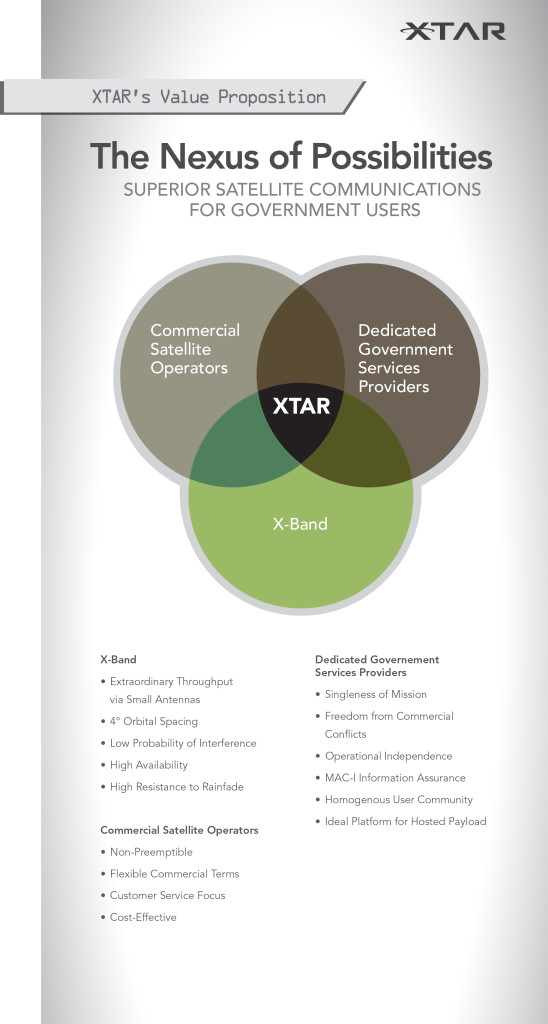The Nexus of Possibilities
During my time at XTAR, I have refined my elevator speech on XTAR’s value proposition and how the company is unique in the satellite communications world. To be clear, when I say, “unique”, I mean, one of a kind — not just special. This is because no other company brings together the service characteristics of XTAR.
I often use the term “nexus” to describe the overlapping qualities that define XTAR, and I envision a Venn diagram to help me share our value proposition to the government user. Namely, XTAR combines the best of three sources in the satellite industry: Commercial Satellite Operator, Dedicated Government Service Provider, and the Distinct Characteristics of the X-band frequency range.
After some urging by my colleagues, I created the graphic you see below.
Like other commercial satellite operators, including Intelsat, SES and Eutelsat, XTAR offers a non-preemptible, highly cost-effective, flexible and customer-service focused experience to the user. This is in contrast to MILSAT constellations, which are plagued by preemptibility, limited availability, and performance problems. Some might argue that MILSAT options are “free to the user”. But, if the user is unable to access MILSAT services, what difference does it make that it’s free?
Unlike our commercial counterparts however, XTAR is a dedicated government service provider. It does not — in fact, cannot — pursue commercial users. Our mission is clear:
Deliver secure satellite service and proven capabilities to the government and military users each and every day. Our customer-focused team employs the best available commercial resources and practices along with a heritage of innovative thinking to enable the government mission.
In this way, XTAR is notably different from other commercial satellite operators. If we are unappealing to the government user, we cannot simply sell to broadcasters and direct-to-home Internet providers. Having a niche market focuses us on providing a compelling service. XTAR is unwavering about its support to the government user. When the @#$% hits the fan, XTAR stands with its government customers. We cannot retreat to the safety of commercial applications.
Finally, by leveraging the unique characteristics of the X-band frequency range, XTAR offers government customers the opportunity to realize outcomes which cannot be achieved using other frequency bands. Seated between Ku and C-band on the RF spectrum, X-band delivers high resistance to atmospheric interference (i.e. rain fade) and the ability to achieve high throughput from small antennas. Reserved for a short list of users (the mostly highly trained government and military communications experts) and payloads that are deployed 4 degrees apart dramatically decreases the chance of interference.
X-band’s physical characteristics and reserved user status result in the ability to push extraordinary amounts of data from ultra small apertures (e.g., 6″x6″) using a fraction of the bandwidth needed in other frequency bands. X-band is a unique resource for the government user to achieve what cannot be done in any other frequency band. And, by the way, XTAR’s solutions are typically less expensive than our competitors in C, Ku, Ka, and even X-band, on a MHz basis and on a Mbps basis.
When the key strengths of Commercial Satellite Operators, Dedicated Government Services Providers, and Distinct X-band Characteristics are viewed together, you’ve got XTAR — a one of a kind resource for the government user.
